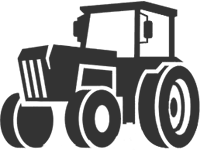Transporting Cattle, Hogs & Sheep
Hauling livestock can be very profitable, but it requires a larger investment of time for each load and drivers who are patient and compassionate with the animals. If you’re interested in adding livestock hauling to your company’s services, here are some considerations to keep in mind.
How To Transport Livestock?
Livestock hauling is very different than transporting a load of shelf items. Not only are drivers responsible to live animals while on the road but they also often help load and unload the livestock which means they need to know proper care. With any type of livestock, it is important that they be moved in a manner that minimizes stress and pain. That means electrical prods should only be an absolute last resort. Emphasis should be placed on flight zone and point of balance techniques, especially with cattle and hogs, to approach the animal in a way that does not elevate their stress and to guide them with gentle methods such as flags, paddles, or panels.
What Trailer Do I Need For Shipping Cows, Pigs & Sheep?
Livestock trailers with proper ventilation and made from materials that allow a thorough cleaning to prevent disease are a necessity. These trailers are designed for animals are better able to withstand the beating they will get from the livestock. Floors should have a non-slip surface to prevent any injuries. Ensure the trailer is large enough to accommodate the proper spacing between animals according to their size.
How To Load Pigs Into A Trailer?
When loading hogs, ensure loading ramps have a non-slip finish and that the ramp angle does not exceed 20 degrees on non-adjustable ramps or 25 degrees for adjustable as their heart rate increases with steeper ramps. Cleats on the ramps need to be spaced for the animal’s natural walking stride to prevent leg injuries. For a 250-pound hog that would mean eight inches using a cleat measuring one square inch.
What Permits Do I Need To Transport Livestock?
Inspection requirements and paperwork varying according to departure location, destination, and the distance of travel. When transporting animals across state lines and sometimes within a state, a certificate of veterinary inspection is usually required and most states have additional requirements as well. Some categories such as swine, must have individual identification unless kept as a group, while others, such as cattle moving directly to slaughter, do not need individual identification. Sheep and goats crossing state lines are required to have an official scrapie identification.
How Does Weather Impact Livestock Transportation?
All animals are affected by heat and cold. Hogs, for example, cannot sweat to regulate their body temperature, which makes transportation in hot, humid conditions dangerous. Transport should be done in early morning or late in the afternoon and stocking density reduced when temperatures are above 77 degrees Fahrenheit. Cold temperatures can also be hazardous. Bedding of straw is required when the temperature gets below 32 degrees Fahrenheit and some ventilation holes will need to be blocked.
How To Find Livestock Loads?
Finding and bidding on loads is easy with FR8Star. On the Load Board, use the drop-down filters to set your shipment type to “livestock.” You can create additional filters such as location (including specific states and mileage ranges within a specific ZIP code), distance (minimum or maximum mileage), and weight as well.
FR8Star has a Freight Rate Calculator that factors in the load information provided and gives carriers a cost estimate based on freight size, permit requirements, and other factors. Companies can adjust the formula based on the current mileage costs and market forces to create instant rates for the shipper before bidding starts.
After filtering loads and selecting one to bid on, haulers can review load information, including the Freight Rate Calculator estimate, and enter their bid, pickup and delivery date range, and other information. Haulers can also communicate with customers via the messaging system or, for Pro Subscription users, contact the customer directly.
Once the bid is submitted, the shipper can review the details and compare with other bids as well as any details haulers have added about their company and number of loads hauled using FR8Star. Shippers can message haulers directly for additional questions and accept bids any time before their set expiration date and time. FR8Star immediately connects haulers and shippers once the bid is accepted.
 Equipment & Machinery
Equipment & Machinery
 Freight
Freight
 Container
Container
 Livestock
Livestock
 Commodities
Commodities